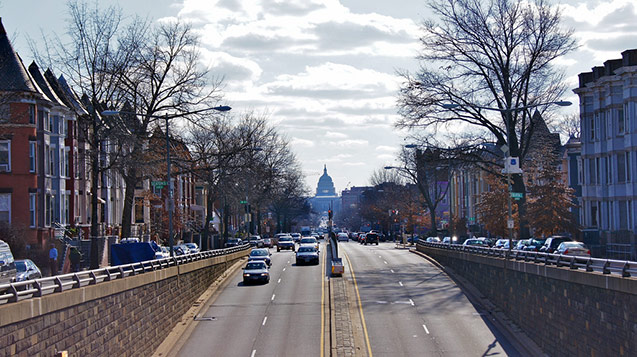 (Photo: Ted Eytan / Flickr)
(Photo: Ted Eytan / Flickr)
Barry Farm, a public housing complex in southeast Washington, “is the line in the sand,” says Schyla Pondexter-Moore, a community organizer. “If you take away Barry Farm, you’re basically just giving away the whole Ward 8.”
Barry Farm is the latest battleground for grass-roots housing advocates in the nation’s capital, where intense gentrification has altered the city’s demographic landscape dramatically. Because Washington was America’s first city to have a black majority, it came as a shock to many in 2011 when DC’s black population dropped below 50 percent for the first time in more than 50 years. In the past decade, the district lost nearly 40,000 black residents, many driven out by skyrocketing rents fueled by an influx of mostly white professionals flocking to increasingly gentrified neighborhoods.
Until recently, Wards 7 and 8 – the district’s poorest, most segregated and longest-neglected wards – largely were untouched. But as developers become desperate for new real estate to flip, residents living east of the Anacostia River (the unofficial dividing line between the city’s haves and have-nots) are seeing the beginning stages of gentrification take shape, starting with plans to demolish public housing, like Barry Farm. And if the past decade has taught them anything, it is that gentrification usually leaves longtime low-income residents out in the cold – literally.
Demolitions and Broken Promises
If the DC Housing Authority and developers have their way, all 434 public housing units at the Barry Farm complex will be razed to make room for “mixed income” housing, part of a four-phase $400 million redevelopment plan under DC’s New Communities Initiative, a public-private urban revitalization partnership modeled after the federal Hope VI program.
But if the past is any indication, New Communities is far more likely to displace Barry Farm residents indefinitely, as the former residents of DC’s Temple Courts public housing complex can attest.
Prior to its demolition in December 2008, the Temple Courts property, in Ward 6 at North Capitol Street and K Street Northwest, was plagued with drug-related crime, which the city used as justification to tear it down. Then-Mayor Adrian Fenty promised that the squeaky-clean $700 million mixed-income community that developers planned to build over the ashes of Temple Courts would include at least 570 affordable units that would allow all families displaced by the demolition an opportunity to return by the 2009-10 school year. Five years later, what used to be Temple Courts is now a parking lot that charges $8 an hour. Consequently, only 22 of the more than 200 families that were forced out have moved back in.
As noted in a joint WAMU and NPR investigative series, similar promises were made to residents living in more than 700 public housing units at the Arthur Capper and Carollsburg complex in southeast Washington a decade ago. “What is there now, among other things, are million-dollar homes and parking lots for the baseball stadium nearby,” the investigation revealed.
Barry Farm
“Some people say it’s an eyesore, it needs to go. But there’s a lot of history behind Barry Farms,” said Pondexter-Moore, who works as an organizer at Empower DC, a grass-roots community-led organization.
Indeed, Barry Farm has deep roots in African-American history, although not many are aware of it, which the documentary film Barry Farm: Past & Present sought to correct.
In 1867, after the Civil War, the US Bureau of Refugees, Freedmen, and Abandoned Lands, otherwise known as the Freedmen’s Bureau, bought 365 acres of farmland from white landowners David and Julia Barry. The land was sold for $125 to $300 per acre to newly freed slaves in what quickly became DC’s first freedmen’s community, Barry Farm. A portion of the profits were then used to build Howard University, which started out as an educational institution for the residents of Barry Farm, who built their homes and the surrounding neighborhood from scratch.
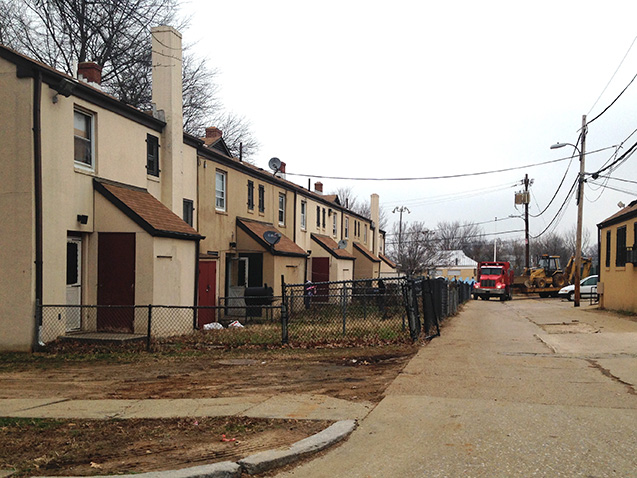 A row of public housing units in Barry Farm. (Photo by Rania Khalek)
A row of public housing units in Barry Farm. (Photo by Rania Khalek)
Phyllissa Bilal, a 46-year-old Barry Farm resident and mother of six, is on the front lines of the fight to keep her community intact as co-founder of the Barry Farm Study Circle.
She had no idea Barry Farm was slated for redevelopment until after she moved in and was recruited to join the city’s six-person planning development team – made up of two Barry Farm residents, two members of the DCHA and two people from the deputy mayor’s office – a position she ultimately quit after concluding they weren’t interested at all in her input and only wanted residents on the team to give the appearance of resident approval for development plans.
Bilal told Truthout that DCHA routinely fails to properly notify residents of public meetings about redevelopment plans and has even kicked people out of public meetings via police escort when backlash to developer plans has erupted. Meanwhile, DCHA is doing all it can to push people out of Barry Farm, even resorting to underhanded tactics, Bilal said. In one instance, DCHA offered to pay residents $25 to fill out a survey with questions that, depending on the answer, could instantly disqualify people from public housing, she told Truthout.
Of course, there are residents who support tearing down Barry Farm, but community activists blame government neglect.
“The government has divested in these places for so long that some of the people who live there actually start to believe that it needs to be shut down,” Pondexter-Moore said. Dominic Moulden, an organizer with the grass-roots organization One DC, agrees. “If anything is wrong with Barry Farms, it’s because the government didn’t take care of it,” he said.
At Barry Farm, Bilal said the city is using this neglect to its advantage. By failing to carry out routine maintenance, Bilal said, the government is “purposely making these units uninhabitable” and using failed inspections as a pretext for kicking people out. “It’s another tactic they’re using to move people off the property,” she said. At one point, she said, residents were receiving three to four inspection letters a week.
Moulden gave me an unofficial tour of Barry Farm, during which he pointed to boarded-up windows and doors of units that were no longer inhabited.
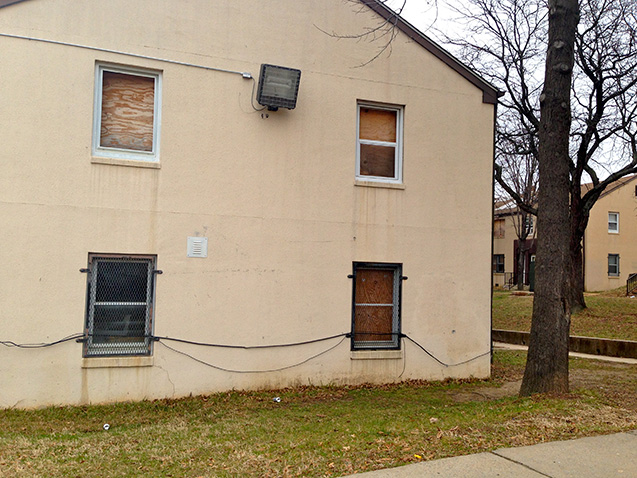 A boarded-up unit at Barry Farm public housing complex. (Photo by Rania Khalek)
A boarded-up unit at Barry Farm public housing complex. (Photo by Rania Khalek)
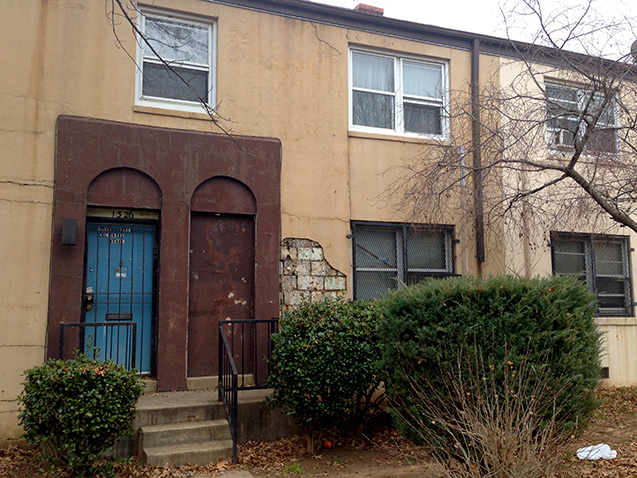 Mold grows on a boarded-up door at an empty Barry Farm unit. (Photo by Rania Khalek)
Mold grows on a boarded-up door at an empty Barry Farm unit. (Photo by Rania Khalek)
Adjacent to the decaying and boarded-up homes in Barry Farm from which people had been evicted was a massive construction site for a 47,000-square-foot recreation facility that will include one of the largest indoor swimming pools in Washington.
“Do you think they want that for the people that live here now?” Moulden asked. “Why didn’t they build that years ago? Why are they building it when they’re moving people out?”
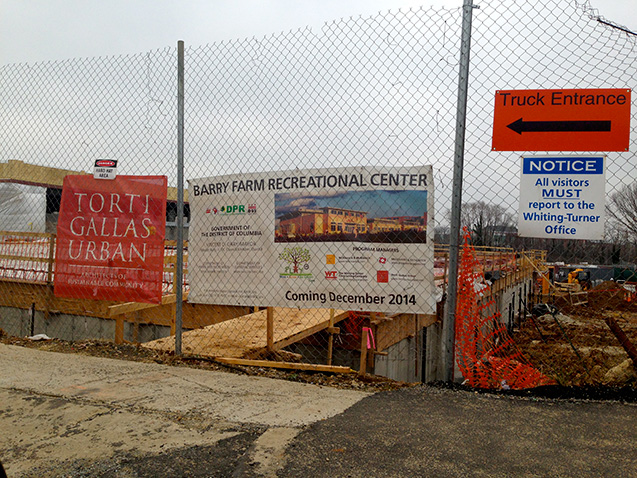 Construction site of the new Barry Farm Recreation Center. (Photo by Rania Khalek)
Construction site of the new Barry Farm Recreation Center. (Photo by Rania Khalek)
Rebranding Anacostia
Moulden also gave me an unofficial tour of Anacostia, one of the district’s poorest Ward 8 neighborhoods long defined by poverty and crime by outside observers, particularly the media – which are quick to highlight stories that reinforce Anacostia’s negative image. But recent years have seen plans by developers to revitalize the historic neighborhood through gentrification, which posits that luring more-affluent people to the area will attract businesses, leading to a more-prosperous economy for everyone, most of all the poor.
But for grass-roots community-led organizations such as Empower DC and One DC, the answer to lifting people out of poverty lies not in the presence of wealthier and whiter residents but in investing in poor communities.
“If you want an equitable society, you have to invest in the people in the neighborhood. And that’s what [the government] don’t do,” Moulden said.
“There’s been nothing effectively implemented in our communities to uplift people,” Pondexter-Moore said. “We’ve got a lot of liquor stores and fast food places that are bad for our health. But we don’t have things like a nice skating rink or maybe a radio station that somebody could run. We don’t have services that would help people in public housing maybe form a small business and hire people in the neighborhood. We have a lot of social service programs, which do help, but nothing that’s going to effectively deal with the issue of crime.”
What’s most frustrating for many people in these communities is that the nice stuff doesn’t surface until affluent people move in.
For example, Moulden said plenty of black children rode bikes, and some even started a co-operative bike store in the Shaw neighborhood. But it wasn’t until the neighborhood was gentrified – white residents in Shaw’s 20001 ZIP code rose from 5.6 percent of the population in 2000 to 32.8 percent in 2010 – that bike lanes were installed.
Moulden occasionally would point to a bike rider whizzing by during the tour, noting that not one of the 72 miles of bike lanes that wind across DC are in Ward 8.
“Now they’re saying they’re ready to invest, but only because they’ve figured out how to remove people,” Moulden said.
“All these years that we’ve been asking for this very thing, and now it’s coming – but for someone other than you,” Pondexter-Moore said. “We need to fight, not to just keep our communities. But we need to fight for the same improvements that these newcomers are getting. We don’t want the same high retail stuff. But we do want a CVS and a grocery store.”
Anacostia’s only supermarket was closed last year, forcing residents to travel more than a mile to reach the nearest grocery store. But, as Pondexter-Moore said, there is no shortage of liquor stores, which can be found on every block, making flashy new spots like the Anacostia Arts Center near the intersection of Good Hope Road and Martin Luther King Jr. Avenue stand out.
According to its website, the art center is dedicated “to creating a home for small businesses, artists, arts and cultural organizations to fulfill our commitment to the revitalization and sustainable economic development of Historic Anacostia.”
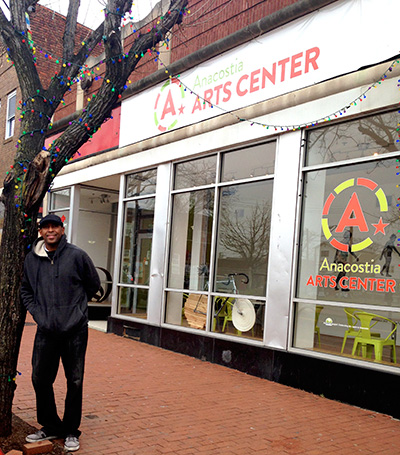 Dominic stands outside the Anacostia Art Center on Good Hope Road. (Photo by Rania Khalek)
Dominic stands outside the Anacostia Art Center on Good Hope Road. (Photo by Rania Khalek)
Not far from the art center is The Hive 2.0, an organization that hosts small-business workshops open to the public and offers its hip office space to “innovators, visionaries and entrepreneurs” at a monthly cost unaffordable to most nearby residents.
The Hive and the Anacostia Arts Center are projects of the ARCH Development Corporation, whose chief executive wants to turn Anacostia into the epicenter of DC’s emerging art scene. Although it sounds like a noble goal, Moulden questioned whom the art is supposed to benefit, especially when it seeks to bring new people into the area without addressing the needs of underserved residents already living there.
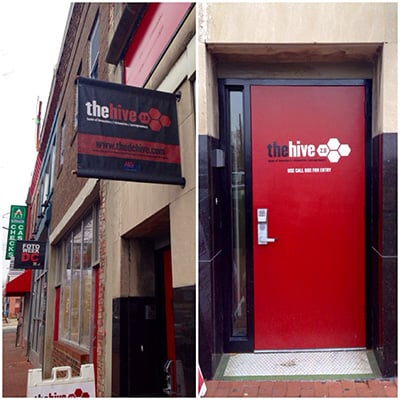 The Hive 2.0 on Good Hope Road in Anacostia. (Photo by Rania Khalek)It wouldn’t be the first time developers and city planners turned to the popular method of luring artists into poor neighborhoods to help kick off gentrification efforts, only to then price out the artists once they’ve fulfilled their role in rebranding the area, a phenomenon playing out in places like New York City’s Bushwick neighbhorhood in Brooklyn.
The Hive 2.0 on Good Hope Road in Anacostia. (Photo by Rania Khalek)It wouldn’t be the first time developers and city planners turned to the popular method of luring artists into poor neighborhoods to help kick off gentrification efforts, only to then price out the artists once they’ve fulfilled their role in rebranding the area, a phenomenon playing out in places like New York City’s Bushwick neighbhorhood in Brooklyn.
Deconcentrating Poverty
The underlying premise of housing programs like the DC’s New Communities Initiative and the federal Hope VI program is that perpetual poverty is the result of too many poor people living in the same place. Therefore 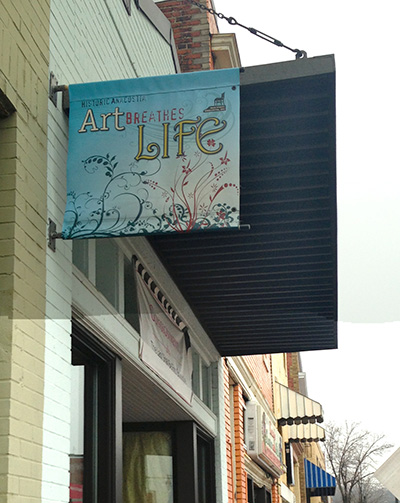 “Historic Anacostia: Art Breathes Life” sign outside Anacostia storefront. (Photo by Rania Khalek)the only way to alleviate the social ills connected to poverty is to tear down low-income communities and disperse the residents, a concept otherwise known as “deconcentrating poverty.”
“Historic Anacostia: Art Breathes Life” sign outside Anacostia storefront. (Photo by Rania Khalek)the only way to alleviate the social ills connected to poverty is to tear down low-income communities and disperse the residents, a concept otherwise known as “deconcentrating poverty.”
Despite little to no proof that it works, poverty deconcentration became gospel to urban elite planners in the early 2000s, helping to guide the demolition of thousands of public housing projects in cities across the country.
Pondexter-Moore told Truthout that as a 37-year-old mother of four who grew up in DC and is raising her children in public housing, she finds the idea of deconcentrating poverty insulting.
“For government officials and nonprofits to tell me that it’s not good for all of ‘you’ to live together in one area, you’re making me believe that there’s something wrong with me,” said Pondexter-Moore, who currently lives in public housing in Ward 8. “It’s pure ideology that’s based on what people think. There’s no proof that it works or is effective. How can you promote and implement a policy based on what you think?”
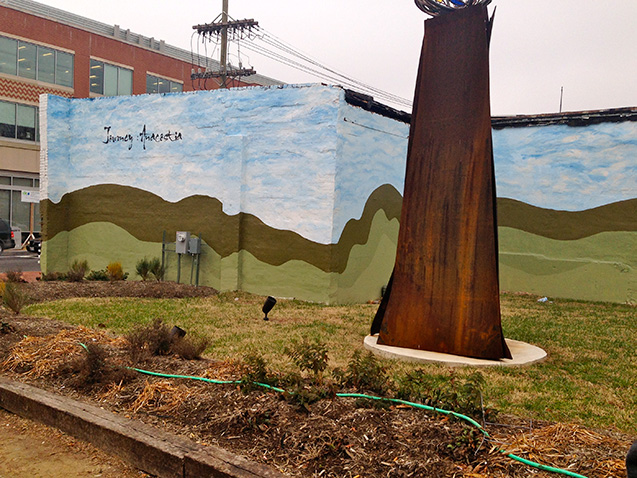 Journey Anacostia public art mural and sculpture installation at the intersection of Good Hope Road and Martin Luther King Jr. Ave. It is a joint project of DC Commission on the Arts and Humanities and the DC Department of Housing and Community Development. (Photo by Rania Khalek)
Journey Anacostia public art mural and sculpture installation at the intersection of Good Hope Road and Martin Luther King Jr. Ave. It is a joint project of DC Commission on the Arts and Humanities and the DC Department of Housing and Community Development. (Photo by Rania Khalek)
“There’s no other program like public housing, so if you demolish it and replace it with stuff that we can’t qualify for, then what does that leave us with?” asked Pondexter-Moore. “The people who advocate for public housing to be demolished are basically advocating homelessness. That’s the only outcome of this.”
According to the most recent data compiled by the National Low Income Housing Coalition, the average rent for a two-bedroom apartment in DC is $1,412 a month, the second highest in the nation. To afford rent in DC without spending more than 30 percent of their income on housing, a renter would need to earn $27.15 an hour, over three times DC’s $8.25 hourly minimum wage. In other words, a minimum wage earner would need to work 132 hours a week to pay rent in the district.
Since 2000, DC has demolished at least nine public housing properties, which coincides with the city losing more than half its low-cost housing units in the past decade. Meanwhile, DC’s homeless population has quadrupled since 2008.
It’s no wonder then that there are more than 70,000 names on the city’s public housing waiting list, which was indefinitely closed to new applicants in April 2013 because of protracted wait times. With one of the least affordable housing markets in the country and only 8,700 public housing units, the city’s housing crisis is closer to an emergency.
Yet the race to tear down what little public housing is left has continued unabated. And Ward 8 is the latest frontier.
Join us in defending the truth before it’s too late
The future of independent journalism is uncertain, and the consequences of losing it are too grave to ignore. We have hours left to raise the $12,0000 still needed to ensure Truthout remains safe, strong, and free. Every dollar raised goes directly toward the costs of producing news you can trust.
Please give what you can — because by supporting us with a tax-deductible donation, you’re not just preserving a source of news, you’re helping to safeguard what’s left of our democracy.